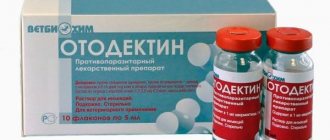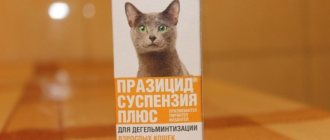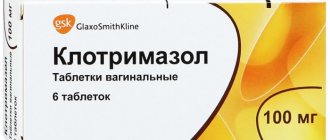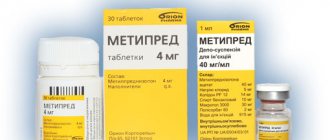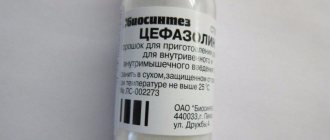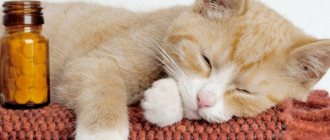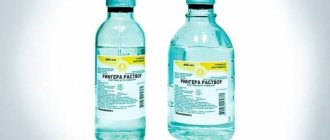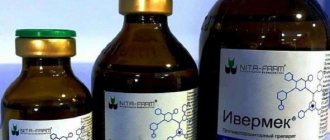Description of the drug Amitrazine
Amitrazine is a complex acaricidal solution for external use. It is produced by the St. Petersburg joint-stock company "Top-Vet", specializing in the production of veterinary drugs. This product is an oily translucent liquid of a pale yellow color, which contains the following components:
- amitraz (0.25%) is a weak organic acid that is an acaricide for many types of ticks; when exposed to it, the conduction of nerve impulses is blocked, which leads to paralysis and death of the parasites;
- dimethyl sulfoxide (30%) - this component promotes the rapid penetration of amitraz into the deeper layers of the skin, and also has local anesthetic and anti-inflammatory properties;
- rapeseed oil is an excipient that also has antioxidant, bactericidal, anti-inflammatory effects; improves the condition of the animal's skin and fur, promotes rapid regeneration of the skin.
The drug is sold in 10 ml dropper bottles.
In most cases, one package of Amitrazine is sufficient to treat a cat.
How long can Amitrazine be stored?
Before opening the package, the drug can be stored for two years from the date of release. Storage conditions meet the requirements for low-hazardous substances:
- the product is stored separately from food and animal feed;
- children cannot have access to the place where the drug is stored;
- packaging must be protected from high humidity and light, ambient temperature: from 0 to -20 °C.
After the bottle has been sealed, the medicine can be stored for no more than 30 days in a closed container.
Composition and release form
Amitrazine is available in the form of an oily solution. It has a specific smell. The drug is produced by several domestic pharmacological companies, so in pharmacies you can find the medicine in different packages. Typically, polymer bottles of 10 ml are used (rarely larger volumes), equipped with droppers for ease of use. Amitrazine is also found in clear glass bottles, sealed with rubber stoppers and aluminum caps. In this case, the medicine is equipped with a plastic dropper, which is placed on the bottle after opening.
The basis of the drug is amitraz. The solution contains 0.25% of the active substance. Also contains rapeseed oil and dimethyl sulfoxide. Thanks to them, the active substance penetrates the skin faster and begins to destroy parasites. In addition, auxiliary components soften the effect of the medication.
Indications for use of Amitrazine
Amitrazine can be prescribed to cats to combat various skin diseases:
- otodectosis;
- notoedrosis;
- sarcoptic mange.
Otodectosis (ear scabies)
This disease occurs when infected with Ototdectes cynotus (ear mites), the development and reproduction of which takes place on the inner surface of the auricle. As a result of the vital activity of a colony of parasites, their waste clogs the ear, which can lead to otitis media, and in especially advanced cases, to the death of the animal. The first signs of the disease are:
- itching (the cat often scratches its ear);
- contamination of the auricle;
- discharge from the eye - with severe infection;
- emergence of the third century.
Video: otodectosis in cats
Notoedrosis and sarcoptic mange
Notoedrosis is caused by the subcutaneous mite Notoedres cati. Infection most often begins from the animal's head, and if left untreated, spreads throughout the body. The mite parasitizes in the upper layers of the skin, which leads to cracking, the appearance of pustules, thickenings, and then caked reddish crusts form on the skin. In areas of severe damage, hair may fall out. Because of the itching, the cat constantly scratches itself, further injuring itself. Damage to the skin that occurs as a result of the disease not only causes suffering to the cat, it can lead to decreased immunity, secondary infection, the development of an inflammatory process and the death of the pet.
The fight against subcutaneous mites should be started as early as possible so as not to lead to the spread of the disease
Sarcoptic mange is caused by the mite Sarcoptes canis. It penetrates into deeper layers of the skin than Notoedres cati, also causing itching and damage to the skin. The first signs of sarcoptic mange are local redness of the skin near the ears, around the eyes, and in the area of the eyebrows. After a few days, cracks and small bubbles appear in these places, which burst with the release of ichor.
The main signs of a subcutaneous mite are hair loss, redness and the appearance of blisters on the skin.
The general course of the disease with sarcoptic mange is similar to notoedrosis, and it is possible to accurately determine the cause of the disease only by doing an analysis at a veterinary clinic.
Video: subcutaneous mites in cats
Drug analogues
Amitrazine analogues include:
Amit Forte. A yellowish solution available for sale in bottles of 10, 15, 20 or 30 ml, or in disposable pipettes of 1 and 1.4 ml. The main active ingredient is fipronil. The drug is used for demodicosis, infection with scabies and ear mites. Diphenhydramine, which is part of the composition, has a calming effect.
Decta Forte. An oily solution with a light brown or yellow tint. It goes on sale in plastic bottles of 10 ml. The main component is fipronil. It also contains the anesthetic component lidocaine and the antibiotic chloramphenicol. The product is effective when your pet is infected with scabies and ear mites. It is also used to treat demodicosis.
Aversectin ointment. A homogeneous mass with a slightly yellowish tint. The main component is aversectin. Also included are glycerin and polyethylene oxide. It goes on sale in cans of 15, 20, 30, 60 and 500 grams. The medicine is effective against ear, subcutaneous and scabies mites.
How to use Amitrazine
Schemes for using Amitrazine to combat ear and subcutaneous mites differ.
Treatment procedure for otodectosis
For otodectosis, treatment with Amitrazine is carried out as follows:
- After moistening the swab with the preparation, thoroughly clean the inner surface of the ear from all contaminants. Not all veterinarians recommend cleaning the ear with a mite killer, as it is still somewhat toxic. For this purpose, you can use milder preparations, for example, lotions with an anti-inflammatory effect: Bars, Cliny and others.
You can clean your pet’s ear before treating with Amitrazine using any ear lotion intended for cats.
- After this, 0.5 ml (about 10 drops) of Amitrazine is instilled into the ear canal (this volume of the drug is indicated in the instructions for use, but it is still better to check the dose with a doctor). You can more accurately determine the volume using an insulin syringe. Then the auricle is bent and lightly massaged at the base. Massaging ensures the penetration of the medicine into all internal cavities of the ear.
- This procedure is repeated for the second ear. Treatment is mandatory for both ears, even if there are no signs of disease in one of them.
- A week later, the treatment is repeated.
According to the instructions for use of Amitrazine, two treatments are sufficient, since the full development cycle of a tick is about 9 days, and within a week, all the eggs will hatch into larvae that will die after the second treatment. But this is ideal. The auditory concha has a complex shape, and if at least one mite remains somewhere in the folds, after a while the disease will resume. Therefore, it is still better to carry out several treatments to ensure that all parasites are destroyed.
If the drug gets on an open wound, it causes severe pain, so if the skin and inner cavity of the ear are injured, it must be applied with caution.
If tick infection has already led to the development of otitis, additional treatment is carried out to relieve the inflammatory process, which is prescribed only by a veterinarian.
Video: how to clean a cat's ears
Scheme for using Amitrazine against subcutaneous mites
Treatment procedure for Amitrazine against subcutaneous mites:
- It is advisable to cut the hair in the affected areas to make it more convenient to apply the drug, while keeping in mind that 10 mm of healthy skin is captured in the border zone.
- Clean off any scabs and crusts from the affected areas. To soften scabs, you can use warm water with the addition of tea tree oil extract, calendula, kelp or other substances with keratolytic and disinfectant properties.
- Apply Amitrazine with a swab to the affected areas, starting from the border zones, moving towards the center. The dosage is calculated according to the formula 0.2–0.5 ml (depending on the degree of development of the disease) per 1 kg of cat weight.
- Animals should not be allowed to lick the drug for 15–20 minutes. To do this, you can use a veterinary cone or simply wrap the cat in a towel and hold it in your arms.
For 20 minutes after treating the skin with Amitrazine, you can put an Elizabethan collar on the cat.
This procedure is carried out two to five times, depending on the development of the disease, every 5–7 days. In case of severe damage, each treatment is carried out in two stages: first, one half of the body, the next day - the second. This precaution is necessary to prevent an overdose of the drug. When fighting microscopic mites, a repeated treatment procedure is required, since the drug affects only the larvae and adults of the parasite; it does not destroy mite eggs.
The animal’s recovery is determined based on the results of the veterinary clinic’s analysis.
Amitrazine instructions for cats and its dosage
Before use, the animal's jaw should be closed with a braid to prevent the pet from licking itself. The ears must be cleaned of any crusts, scabs, and earwax that have formed. The auricle is folded in half and massaged a little at the base to warm the skin and improve the effect. A solution at room temperature is applied to the affected areas. This should be done in such a way as to cover the area around the fireplace by one or two centimeters.
Treatment is carried out until the symptoms disappear: with demodicosis, 7 treatments are usually required, for other diseases - about 4-5. The medicine must be applied once a day every three days. You can instill the medicine with a pipette or apply it with a cotton swab.
The dosage is selected based on the weight of the animal - for example, for adult cats, 0.5 ml is needed in each ear. 20 minutes after application, the tape can be removed - during this time the product has been absorbed, and the animal will not be able to lick it off. You can talk about a complete recovery only after taking a test at a veterinary institution; it must give a negative result.
Amitrazine is an effective medicine for four-legged friends: it actively fights parasites, is easy to apply, and does not require close supervision by a doctor.
The drug is low toxic. Prescribed for the treatment and prevention of ear and skin mites in pets.
Is it always possible to use Amitrazine?
The drug belongs to substances of the third class of danger. When used in the indicated dosages, it has no locally irritating or sensitizing (increasing the body's sensitivity to allergens) properties. There are restrictions on its use; in some cases, Amitrazine is not prescribed:
- when the animal’s body is weakened;
- during infectious diseases;
- pregnant and lactating females;
- kittens up to 8 weeks of age.
Contraindications and side effects
And although Amitrazine is considered a non-toxic drug, it has a number of contraindications. It should not be used for treatment in the following cases:
- during pregnancy;
- during lactation;
- for kittens up to 2 months of age;
- with severe exhaustion;
- for infectious diseases.
You should also avoid using it if you have an individual intolerance to the components.
Amitrazine usually does not cause side effects, but if the components are intolerant, allergic reactions may occur, which are manifested by skin pathologies or other symptoms. In rare cases, animals experience weakness and disruption of the digestive system (vomiting or upset stomach).
Note! When the medicine is applied to scratched areas and wounds, a burning sensation occurs, which quickly passes.
Side effects that are possible when taking the drug
Not all animals tolerate Amitrazine well; some exhibit a negative body reaction to this drug. Such phenomena include:
- allergic rashes, redness, itching, swelling;
- a state of general loss of strength;
- aggressive behavior of a cat due to unpleasant sensations.
If such a reaction occurs, the drug must be removed by washing it off with warm water using a cotton swab. If the animal's condition does not improve, you need to contact a veterinarian.
In case of overdose or poisoning by the drug (if the animal accidentally licked the medicine), the following symptoms may appear:
- nausea and vomiting;
- diarrhea;
- dilated pupils;
- refusal of food;
- bradycardia;
- general weakness of the body.
In this case it is necessary:
- If possible, remove the drug from the skin;
- give the cat plenty of fluids;
- give an absorbent (activated carbon is used for this purpose at the rate of 2 g/kg of mass), Antisedan can serve as an antidote;
- Take your pet to the veterinary clinic as quickly as possible.
Table: advantages and disadvantages of Amitrazine
| Advantages | Flaws |
| Effective for many types of skin diseases | Possible side effects |
| Easy to use | There are examples of drug poisoning |
| Relatively low cost (72–85 rubles per bottle) |
Side effects
If you use the drug in accordance with the rules described above, side effects are extremely unlikely. Their development is much more likely in cases of overdose, unreasonably long treatment, as well as special cases (such as individual intolerance to the components of the drug):
Redness and mild inflammation of the treated skin areas. In more severe cases (or when the owner does not pay attention to it), the process can develop until the skin becomes rough and deep cracks appear on it. They often bleed and local pain occurs. Worst of all, when the process reaches the formation of ulcerative and necrotic lesions, the development of drug-induced dermatitis and eczema is also possible. In addition, one should not forget about the possibility of developing allergic reactions if there is an individual intolerance to the drug
In addition, one should not forget about the possibility of developing allergic reactions if there is an individual intolerance to the drug.
Traditional ways to combat skin diseases
If it is impossible to use Amitrazine, you can use traditional methods of treatment. To combat subcutaneous mites, bathe the cat every three days using tar soap or special shampoos. Then the wounds on the body are treated with herbal tinctures with a bactericidal and anti-inflammatory effect:
- sage;
- chamomile;
- calendula;
- Echinacea.
For the treatment of otodectosis, the following recipes can be suggested:
- Brew two teaspoons of green leaf tea with a glass of boiling water. Infuse until completely cooled, then filter. Place 2-3 drops daily in each ear for a month.
Green tea has excellent antibacterial properties
- For instillation into the ears, almond oil or other essential oil with an anti-inflammatory effect is used: lavender;
- chamomile;
- tea tree oil.
Traditional methods undoubtedly act on the body in a more gentle way than pharmaceutical drugs. But the result of their use is less effective, and such drugs can only be used in the early stages of the disease. It may make sense to use them to contain the disease until veterinary drugs can be used. But in any case, the course of treatment should be discussed with a veterinarian.
Storage conditions
The solution should be stored in a dark place inaccessible to children. The shelf life is 2 years. The optimal temperature range is from 0 to 25 degrees. An opened bottle is best stored in the refrigerator and, very important, for no more than 30 days. A very important point: to treat your pet’s wounds, you need to remove the medicine and let it warm to room temperature.
Ear mites in a cat
Also read: The drug Amit - use and dosage.
Visit the profile section of our Medical Examination forum or leave your feedback in the comments below. More opinions means more useful information, it will be useful to someone. If there are good and interesting videos on the topic of the article, write and I will insert them into this publication.
Table: comparison of Amitrazine with other analogues
| Drug name | Compound | Application | Price |
| Amit Forte is a liquid acaricidal preparation for external use. | Active ingredients:
| It is used for the same diseases as Amitrazine. Ear treatment is carried out at intervals of 3–4 days. For sarcoptic mange, the medicine is applied every five days. | Bottle 20 ml - 160 rub. |
| Decta Forte is a liquid combined acaricidal preparation | The active substances used are:
| Treatment is carried out according to the same scheme as with Amit Forte. The drug belongs to the fourth hazard class; its use is allowed for kittens older than one month. Lactating and pregnant cats are prohibited. | Bottle 10 ml - 130 rub. |
| Aversectin ointment for demodicosis | Contains:
| Used for treatment:
Twice application at weekly intervals is recommended. Not suitable for kittens under two months old, as well as for pregnant and lactating females. | 15 g jar - from 60 to 100 rubles. |
| Stronghold - insecticidal acaricidal drops on the withers against fleas, ticks and helminths | Selamectin solution | One-time use, but adjustments are possible depending on the severity of the disease. It is not recommended for treating kittens under two months of age, as well as for sick and weakened animals. | One pipette - from 285 to 332 rubles. |
Photo gallery: acaricidal preparations for cats
Amit Forte is an inexpensive and fairly popular means of treating ear mites in cats.
Decta Forte is prescribed for dogs and cats with otodectosis, sarcoptic mange and notoedrosis, including those complicated by bacterial microflora
Drops on the withers are a very convenient form of the drug; this medicine is safely and painlessly applied to the animal’s skin
Aversectin ointment has a wide range of treatment for skin diseases
Price and analogues
Available for purchase. Sold in pet stores and veterinary pharmacies. 70% of the medicine is presented in 10 ml vials. The cost varies between 62-85 rubles.
Products with similar effects:
- Decta forte;
- Amit Forte;
- Stronghold;
- Advocate;
- Tsipam.
Even with the most careful care, pets are not immune to parasites. Careful observation of the animal helps to detect ticks in a timely manner and carry out the necessary course of treatment. The complex action of amitrazine will help get rid of the disease at minimal cost and risk for the patient and owner.
Instructions for use
To correctly calculate the drug use regimen, you should clarify the weight of the animal.
Before giving the drug to your pet, you should cover his mouth to prevent premature licking of the solution. To free your cat’s ears from “freeloaders,” you should first clean the shells of crusts and dirt, and then drop in the required amount of medication. For pets whose skin is affected, Amitrazine is applied externally to the affected area and the area around it within 1-2 cm. To calculate the required dosage, you need to know the weight of the cat, since for every kg of the animal’s body weight there is 0.5 ml of medication . The procedure is carried out once a day every 72 hours until the disease is completely eliminated. Usually, for a complete recovery, the pet undergoes 5 to 7 treatments. The drops are well absorbed, so you can free your pet’s jaw within 20 minutes after the manipulation.
Amitrazine for demodicosis in humans
Issues of prevention and treatment of demodicosis are among the main ones in dermatological practice.
From 55 to 100% of the population are carriers of iron ticks and do not have any manifestations of the disease. They parasitize in the hair follicles and in the mouths of the excretory ducts of the sebaceous and meibomian glands on the scalp, face, ears, back, chest and genitals.
Demodex folliculorum longus - long flares live in hair follicles in groups and crawl to the surface at night to mate, which facilitates both diagnosis of the disease and its treatment.
Demodex folliculorum brevis - short mites live in the excretory ducts of the sebaceous and meibomian glands (located along the edge of the eyelashes) alone; they rarely crawl to the surface, which makes them difficult to detect and treat. Demodicosis rarely occurs as an independent disease. Most often, it develops against the background of existing skin diseases, such as rosacea, acne, perioral dermatitis and seborrhea.
Intensive reproduction of parasites occurs when certain complex problems appear in the host’s body and, first of all, when the immune system malfunctions. Therefore, it is first necessary to conduct a comprehensive examination of the patient for the presence of chronic diseases, and at the beginning of treatment, carry out basic basic treatment of the underlying skin disease.
Rice. 1. Demodectic mange on the face and eyelids.
Rice. 2. Ointments, creams and gels are the best means for treating facial demodicosis.
Difficulties in treating demodicosis
When using the most effective acaricidal drugs (chemicals that reduce the number of ticks), treatment often turns out to be ineffective, which is due to the special structure of the external integument of ticks, their larvae and eggs.
The outer shell of the tick is three-layered, especially developed in females. It protects the parasite from external influences. The cuticle has pores - special channels through which water and gas exchange occurs, but large molecules of contact-acting acaricidal agents cannot penetrate. This fact dictates the need for long courses of antiparasitic treatment.
Rice. 3. Demodex mites (view under a microscope).
Features of therapy for facial demodicosis
When choosing antiparasitic treatment, it is necessary to take into account the clinical picture, severity of the disease and concomitant pathology of the patient.
Complex treatment of demodicosis
Treatment of demodicosis should be comprehensive and include acaricidal, anti-inflammatory (including antibacterial), desensitizing drugs and immunomodulators. The patient’s body must receive the required amount of vitamins, minerals and amino acids. If demodicosis occurs against the background of existing skin diseases, they are treated.
Stages of treatment for demodicosis
- At the first stage of treatment, anti-inflammatory drugs are used, hyposensitizing therapy and immune correction are carried out.
- At the second stage of treatment, antiparasitic therapy is carried out.
- At the third stage, drugs are prescribed that reduce sebum secretion, improve the condition of blood vessels and their regulation.
Duration of treatment for demodicosis
Treatment of demodicosis is long-term. Depending on the form and stage of demodicosis, treatment can be extended from 4 weeks to 1 year.
Criteria for the effectiveness of treatment of demodicosis on the face
The criterion for the effectiveness of treatment of demodicosis on the face is the reduction or disappearance of clinical manifestations of the disease and a decrease in the number of mites according to the results of the analysis.
The duration of treatment for demodicosis is dictated by the structural features of the parasite. The effect of the therapy becomes noticeable after 2 - 8 weeks.
Rice. 4. Long mites Demodex folliculorum longus live in hair follicles in groups (picture on the left) and rise to the surface at night to mate. Short mites Demodex folliculorum brevis (picture on the right) live in the mouths of the excretory ducts of the sebaceous and meibomian glands alone, rarely rise to the surface, which makes them difficult to detect and treat.
Anti-inflammatory therapy
- At the first stage of treatment, it is necessary to use drugs that suppress the microbial population. For this purpose, anti-inflammatory drugs for external and systemic use are used. Ointments, creams and gels with antibiotics for external use have a good effect: Metronidazole, Tetracycline or Erythromycin.
- In advanced forms of the disease, antibacterial drugs are used orally. Metronidazole (Trichopol), Tetracyclines, Ornidazole, Monocycline, Doxycycline, Roxithromycin, Erythromycin are shown.
Rice. 5. Metronidazole and Trichopolum are widely used for demodicosis.
Metronidazole for demodicosis
For many years, derivatives of the nitroimidazole group Metronidazole and Ornidazole have been used to treat demodicosis. The drugs have anti-inflammatory, anti-edematous and immunomodulatory effects. They are active against bacteria, single-celled parasites and Demodex mites. They are used internally and externally in the form of creams, ointments and gels.
Metronidazole is used orally for 2 - 4 weeks, 250 mg 3 times a day (standard regimen). Analogs of the drug for internal use are Trichopolum, Klion, Flagyl, etc.
The drug of choice for demodicosis is Ornidazole (Ornisol). It is stronger than metronidazole, well tolerated, and has fewer side effects. Used in courses of 10 days, 500 mg 2 times a day.
For external use it is used:
- Trichopolum cream for demodicosis is used for one and a half months, which is associated with the life cycle of the demodex mite. In advanced cases, treatment is prolonged.
- 1% cream and gel Metrogyl (contains metronidazole). Apply 2 times a day for 3 - 6 weeks.
- Rosamet cream containing metronidazole is applied 2 times a day for 3 to 9 weeks.
- Contains metronidazole, a multicomponent remedy used for demodicosis, Demalan cream. It has anti-inflammatory, dermatropic, antibacterial and antiparasitic effects. It is used for demodicosis of the face, eyelids and ear canal.
- Erythromycin ointment is applied 2 times a day. Do not use the drug for more than 5 weeks due to the rapid development of resistance of microorganisms. For acne, the complex “erythromycin - zinc acetate dihydrate” has a good effect. The prepared solution is applied to the affected areas of the skin 2 times a day - in the morning under makeup and in the evening after washing for 10 - 12 weeks. The drug relieves inflammation and has a comedolytic effect.
- Contains erythromycin and zinc acetate dihydrate Zinerit powder.
Rice. 6. Rosamet cream and Metronidazole gel are preparations for external use.
Rice. 7. Zinerit powder contains erythromycin and zinc acetate dihydrate.
Permethrin for demodicosis
After the disappearance of inflammation, the transition to the treatment of demodicosis with antiparasitic drugs is carried out.
Insecticidal preparations containing permethrin (a group of pyrethroids) have a powerful antiparasitic effect against demodex mites. Pyrethroids penetrate the cuticle of mites and concentrate in the hemolymph.
They bind to the lipid structures of nerve cell membranes, disrupt the functioning of sodium channels, which leads to a slowdown in the repolarization of cell membranes with subsequent death of parasites.
The substance permethrin does not enter the human systemic circulation.
4% Permethrin ointment is applied to the affected areas of the skin and rubbed in with massaging movements. After 24 hours, the ointment is washed off with warm water and soap. A single procedure is often sufficient. But sometimes the procedure needs to be repeated, which is allowed after 14 days.
Other insecticidal preparations:
Spregal spray is used for scabies, but also has a pronounced effect against iron mites. It contains the antiparasitic agents esdepaletrin (esbiol) and piperonyl butoxide. Spregal spray is irrigated onto a cotton swab, through which the drug is rubbed into the affected areas. A positive effect is achieved in 80% of cases.
Source: https://ParazitHelp.ru/parazity/amitrazin-pri-demodekoze-u-ljudej.html
Owner reviews
Olga, owner of a dog and two cats:
“I used Amitrazine drops for my pets when they caught ear mites somewhere. The drug is effective. This is not the first time I have used it, I always manage to get rid of ticks, but animals do not like the burying procedure. The dog, seeing the bottle in my hands, tries to run away from the house. Cats resist less, but it is clear that the medicine causes them discomfort. The bad thing is that an open bottle can only be stored for a month. It’s good that it’s inexpensive.”
Victoria, pug owner:
“I used Amitrazine-Plus to treat a dog’s ear mites. After the first instillation she became deaf, now I don’t know what to do. There are a lot of negative reviews on forums and thematic websites. I regret that I did not read them before using them. I advise other dog lovers never to buy this medicine.”
Restrictions on use and negative effects
Amitrazin, like every pharmaceutical drug, has contraindications that should be taken into account before starting treatment. Thus, the medicine is prohibited for cats that bear and feed kittens, and also have a personal intolerance to any component of the antiparasitic medicine. You cannot treat a purr's body with Amitrazine if it is less than 2 months old. In most cases, the medication is well tolerated and does not provoke side symptoms, but occasionally, during treatment with it, a mild burning sensation may occur in the damaged area. No other negative reactions were recorded when using Amitrazine.
Composition of the product
In appearance, Amitrazine is a fatty, oily, yellowish liquid with a pungent odor.
The drug is available in glass dropper bottles with a volume of 10 ml.
Main active ingredients:
- Amitraz. This is a synthetic organic compound that has pronounced insectoacaricidal activity against fleas, lice, lice, and ixodid ticks. It acts not only on adult parasites, but also on their larvae. Under the influence of the drug, parasites are poisoned, then paralyzed and subsequently killed.
- Decamethoxin - has antifungal and bactericidal effects.
Excipients:
- Dimethyl sulfoxide is an anti-inflammatory agent with an analgesic effect;
- Vegetable oil.
Amitrazine Plus has good penetrating ability. This makes it effective against parasites that are localized in the deep layers of the skin and are insensitive to other antiparasitic agents, including ointments.
Due to its composition, Amitrazine is able to linger in the hairs (hair follicles) and sebaceous glands of the skin, thereby preventing re-infection by parasites.
When is it appointed?
The effectiveness of a drug based on amitraz was proven by Candidate of Biological Sciences Mikheev S.V. in his dissertation on the topic “Amitrazine in the treatment of tick-borne infections in domestic animals,” which describes in detail what types of parasites the drug affects. And that the scientist, that the official instructions recommend the use of Amitrazin drops for such pathological conditions as:
The product is relevant for the treatment of diseases caused by microorganisms.
- Demodecosis. Parasitic infection of a pet's skin by demodex mites, accompanied by severe itching, pustules, and baldness.
- Ear scabies. Acariasis caused by parasitic ear mites Otodectos cynotis. In cats, the ears begin to itch and become inflamed, and black masses appear with a specific odor.
- Notoedrosis. A parasitic disease of cats, the appearance of which is caused by scabies mites of the genus Notoedris cati. With this disease, purrs experience hair loss, disruption of the nervous system and cardiovascular system, itching and inflammation of areas of the dermis.
Description of the drug
The drops are an oily liquid intended for the treatment of diseases such as demodicosis, notoedrosis, and otodectosis in domestic animals. All these ailments are caused by the proliferation of various mites in the ears and on the skin of cats and dogs.
Demodicosis is an infection of the skin of an animal by the demodex mite, manifested by severe itching, baldness, and the formation of abscesses, which often burst and cause irritation.
Notoedrosis is a disease of cats caused by the itch mite, leading to inflammation of the skin, scabies, hair loss, and disrupting the functioning of the nervous and cardiovascular systems.
Otodectosis is a lesion of the external auditory canal in pets, especially fold-eared breeds. It manifests itself as itching, inflammation in the ear, the appearance of sores and black, foul-smelling masses.
"Amitrazine", the instructions for use of which are intended for cats and dogs, effectively copes with these diseases. However, before using it, you should consult a veterinarian to avoid unwanted side effects.
Composition of the medicinal product
Drops have two forms of release, differing in their composition. A product called “Amitrazine” consists of the following components:
- amitraz is the main substance whose action is aimed at combating various types of mites that parasitize the skin or ears of an animal;
- dimethyl sulfoxide - an auxiliary component that has an anti-inflammatory and analgesic effect;
- rapeseed oil - promotes better penetration of the medicine and has healing properties.
"Amitrazine Plus" has a slightly improved composition, which allows you to achieve the desired result even faster. In addition to the above components, this drug contains a substance called decamethoxin, which has antiseptic properties. The combined action of amitraz and decamethoxin not only effectively copes with the disease, but also prevents its reappearance.
